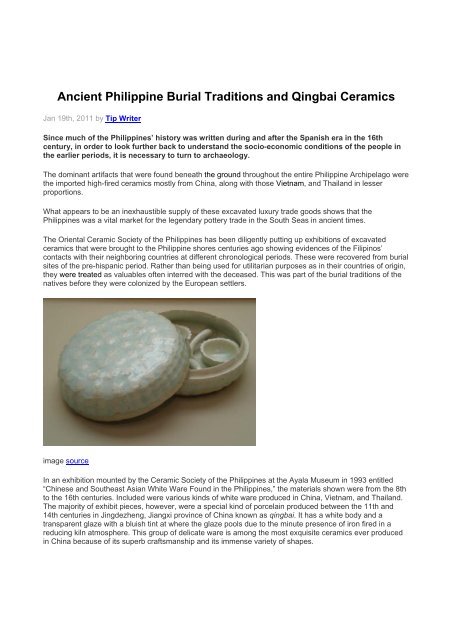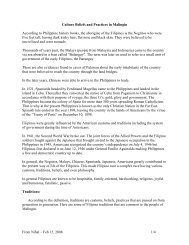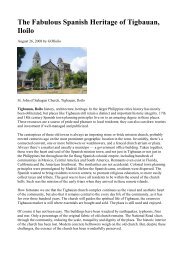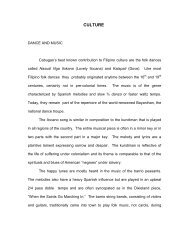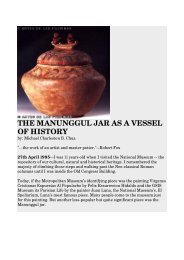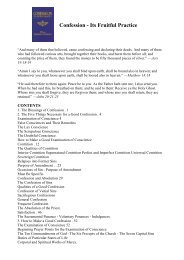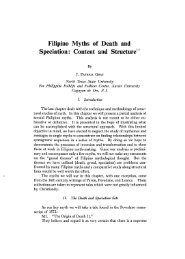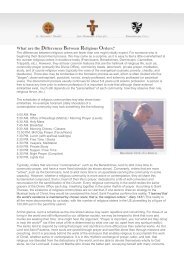Ancient Philippine Burial Traditions and Qingbai ... - Philippine Culture
Ancient Philippine Burial Traditions and Qingbai ... - Philippine Culture
Ancient Philippine Burial Traditions and Qingbai ... - Philippine Culture
Create successful ePaper yourself
Turn your PDF publications into a flip-book with our unique Google optimized e-Paper software.
<strong>Ancient</strong> <strong>Philippine</strong> <strong>Burial</strong> <strong>Traditions</strong> <strong>and</strong> <strong>Qingbai</strong> CeramicsJan 19th, 2011 by Tip WriterSince much of the <strong>Philippine</strong>s’ history was written during <strong>and</strong> after the Spanish era in the 16thcentury, in order to look further back to underst<strong>and</strong> the socio-economic conditions of the people inthe earlier periods, it is necessary to turn to archaeology.The dominant artifacts that were found beneath the ground throughout the entire <strong>Philippine</strong> Archipelago werethe imported high-fired ceramics mostly from China, along with those Vietnam, <strong>and</strong> Thail<strong>and</strong> in lesserproportions.What appears to be an inexhaustible supply of these excavated luxury trade goods shows that the<strong>Philippine</strong>s was a vital market for the legendary pottery trade in the South Seas in ancient times.The Oriental Ceramic Society of the <strong>Philippine</strong>s has been diligently putting up exhibitions of excavatedceramics that were brought to the <strong>Philippine</strong> shores centuries ago showing evidences of the Filipinos’contacts with their neighboring countries at different chronological periods. These were recovered from burialsites of the pre-hispanic period. Rather than being used for utilitarian purposes as in their countries of origin,they were treated as valuables often interred with the deceased. This was part of the burial traditions of thenatives before they were colonized by the European settlers.image sourceIn an exhibition mounted by the Ceramic Society of the <strong>Philippine</strong>s at the Ayala Museum in 1993 entitled“Chinese <strong>and</strong> Southeast Asian White Ware Found in the <strong>Philippine</strong>s,” the materials shown were from the 8thto the 16th centuries. Included were various kinds of white ware produced in China, Vietnam, <strong>and</strong> Thail<strong>and</strong>.The majority of exhibit pieces, however, were a special kind of porcelain produced between the 11th <strong>and</strong>14th centuries in Jingdezheng, Jiangxi province of China known as qingbai. It has a white body <strong>and</strong> atransparent glaze with a bluish tint at where the glaze pools due to the minute presence of iron fired in areducing kiln atmosphere. This group of delicate ware is among the most exquisite ceramics ever producedin China because of its superb craftsmanship <strong>and</strong> its immense variety of shapes.
Various shapes of bowls <strong>and</strong> cups were produced in the Song Dynasty (AD 960-1279). A very unique shapeis that with a high foot, rounded sides <strong>and</strong> slightly reverted rim. This is sometimes referred to as a stem cup.Silver <strong>and</strong> ceramics share quite a number of common shapes. The graceful undulating rim on the vasedecorated with incised peony design is obviously copied from metalwork tradition. Among the twelve piecesof silver of the late Tang period (AD 618-907) discovered underneath a pagoda in Zejiang province in China,there is a bowl with a wide mouth, round base <strong>and</strong> decorated with a net design. It bears a strikingresemblance to the “willow basket” qingbai bowl with the bluish tint trailing right in the center of the netdesign.image sourcewillow basket designWine drinking was a favored social habit of the Chinese in the olden times. Wine ewers were thus producedin enormous quantity by the ceramic potters. Among the profuse extant pieces, there are exquisite variationsthat have become collectors’ items today. The lobing on the body of the ewer with exuberant incised designis another metalwork-inspired feature. The squat body <strong>and</strong> a dragon spout exemplify the wide variety ofshapes that is a remarkable characteristic of qingbai.
There is an interesting array of qingbai sculpture pieces found in the <strong>Philippine</strong>s. They are modeled in theforms of human figures <strong>and</strong> beasts. Most of the pieces are very well articulated, a demonstration of matureskills of the qingbai potters.image sourceIronically, these beautiful Chinese ceramics survive to this date because they were grave wares. Whereasthe dead disintegrated <strong>and</strong> disappeared, the ceramics stay. That some of these excavated ceramic artifactswhich have been buried under the ground for several centuries are still preserved in their pristine conditionsis nearly incredible.Ref.: http://www.bukisa.com/articles/440285_ancient-philippine-burial-traditions-<strong>and</strong>-qingbai-ceramics


